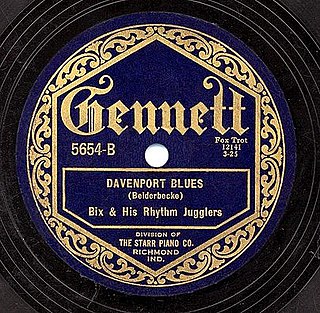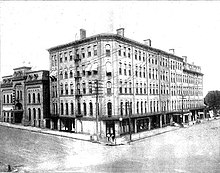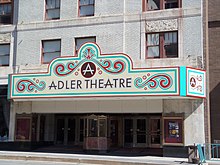
Davenport is a city in and the county seat of Scott County, Iowa, United States. Located along the Mississippi River on the eastern border of the state, it is the largest of the Quad Cities, a metropolitan area with a population of 384,324 and a combined statistical area population of 474,019, ranking as the 147th-largest MSA and 91st-largest CSA in the nation. According to the 2020 census, the city had a population of 101,724, making it Iowa's third-most populous city after Des Moines and Cedar Rapids. Davenport was founded on May 14, 1836, by Antoine Le Claire and named for his friend George Davenport.

The Quad Cities is a region of cities in the U.S. states of Iowa and Illinois: Davenport and Bettendorf in southeastern Iowa, and Rock Island, Moline and East Moline in northwestern Illinois. These cities are the center of the Quad Cities metropolitan area, a region within the Mississippi River Valley, which as of 2023 had a population estimate of 467,817 and a Combined Statistical Area (CSA) population of 474,019, making it the 90th-largest CSA in the nation.

The Bix 7 Road Race is held annually in Davenport, Iowa, as a commemoration to Davenport native and jazz musician Bix Beiderbecke. It is followed a week later by the Bix Beiderbecke Memorial Jazz Festival.

Central High School, or Davenport Central High School is a public four-year comprehensive high school located in Davenport, Iowa. The school building opened in 1907 as "Davenport High School," and is now one of three public high schools part of the Davenport Community School District. The school, whose western side is located along U.S. Highway 61, draws students primarily from the southern, eastern, and central portions of the city.

The Columbus Symphony Orchestra (CSO) is an American symphony orchestra based in Columbus, Ohio. The oldest performing arts organization in the city, its home is the Ohio Theatre. The orchestra's current executive director is Denise Rehg. Rossen Milanov is the orchestra's music director.

Bucktown is a historic area in the eastern end of downtown Davenport, Iowa, along the Mississippi River. Settled by many German immigrants, it was known in the early 20th century during the Prohibition era for its numerous speakeasies. Bucktown garnered national media headlines as a red-light district and the "wickedest city in America."
Bruce Walters, is an artist who has exhibited digital artworks, graphite drawings and paintings primarily in the American Midwest. Walters received his MFA from the University of Wisconsin–Madison and BA from the University of Iowa. He retired from Western Illinois University in 2021 and was conferred with the title Professor Emeritus.

The San Antonio Symphony was a full-time professional symphony orchestra based in San Antonio, Texas. Its season ran from late September to early June. Sebastian Lang-Lessing, its music director from 2010 to 2020, was the last to serve in that capacity. The orchestra was a resident organization of the Tobin Center for the Performing Arts in San Antonio. In August 2022, the orchestra's musicians reformed as the San Antonio Philharmonic, a name first used in 1914, and announced a ten-concert classical-music series for the 2022–23 season to be given at First Baptist Church of San Antonio, 100 yards from Tobin Center.
The Baton Rouge Symphony Orchestra, founded in 1947, is an orchestra located in Baton Rouge, Louisiana, United States. The orchestra performs at the Theater for Performing Arts in the Baton Rouge River Center.
The Dubuque Symphony Orchestra is a non-union, fully professional orchestra located in Dubuque, Iowa. It serves the residents of Dubuque and its surrounding tri-state area which includes 12 counties in Iowa, Illinois and Wisconsin. Under Music Director William Intriligator, over 75 professional musicians perform a repertoire of classical, chamber, opera and pops concerts each year. The DSO performs an average of 12 different concerts a year with a total of 25 performances.
Ballet Quad Cities is a ballet company located in Rock Island, Illinois. It was founded in 1996 by Joedy Cook. The company performs both classical and contemporary dance at various venues in the greater Quad Cities region of Illinois and Iowa.

The LeClaire Park Bandshell, also known as the W.D. Petersen Memorial Music Pavilion, is located on Beiderbecke Drive in LeClaire Park, Davenport, Iowa. It was listed on the National Register of Historic Places in 1983 and on the Davenport Register of Historic Properties in 1993.

The Mississippi Lofts and Adler Theatre is an apartment building and theater complex located in downtown Davenport, Iowa, United States. It is individually listed on the National Register of Historic Places by its original name, the Hotel Mississippi and RKO Orpheum Theater. The Hotel Mississippi was listed on the Davenport Register of Historic Properties in 2005. In 2020 the complex was included as a contributing property in the Davenport Downtown Commercial Historic District.

Leon Bismark Beiderbecke House is a historic building located on the east side of Davenport, Iowa, United States. The house is the birthplace and boyhood home of jazz musician Leon Bismark "Bix" Beiderbecke and so the house is also known simply as the Bix Beiderbecke House. It has been listed on the National Register of Historic Places since 1977.

The Burtis–Kimball House Hotel and the Burtis Opera House were located in downtown Davenport, Iowa, United States. The hotel was listed on the National Register of Historic Places in 1979. It has since been torn down and it was delisted from the National Register in 2008. The theatre building has been significantly altered since a fire in the 1920s. Both, however, remain important to the history of the city of Davenport.
RiverCenter is a convention center located in downtown Davenport, Iowa, United States. It is made up of two buildings sited on the north and south sides of East Third Street connected by a skywalk. The Adler Theatre is connected to the original section of the convention center on the north side of the complex.

Davenport Blues is a 1925 jazz composition written and recorded by Bix Beiderbecke and released as a Gennett 78. The song has become a jazz and pop standard.

Orchestra Iowa is Iowa's premier American symphony orchestra based in Cedar Rapids, Iowa. The current music director and conductor is Timothy Hankewich. Established in 1923 as the Cedar Rapids Symphony Orchestra, the orchestra has 68 professional musicians and a full season of over 180 performances, including a fine arts series, a chamber series, a popular series, and performances with the Cedar Rapids Opera Theatre and Ballet Quad Cities. The orchestra principally performs at the Paramount Theatre located in downtown Cedar Rapids. They also perform regular concerts at Iowa City West High School. The chamber series is performed at the Coralville Center for the Performing Arts in Coralville, Iowa. The orchestra showcases its artistic excellence each season through an accomplished array of classical, ballet, opera, popular and chamber performances, in addition to extensive community education and involvement.
James Dixon was an orchestra conductor and music educator in the United States. During his career he was principally associated with the University of Iowa and the Quad City Symphony Orchestra.
Louise Meiszner was an American pianist and music educator. Her married name was Louise M. Nathanson.



















